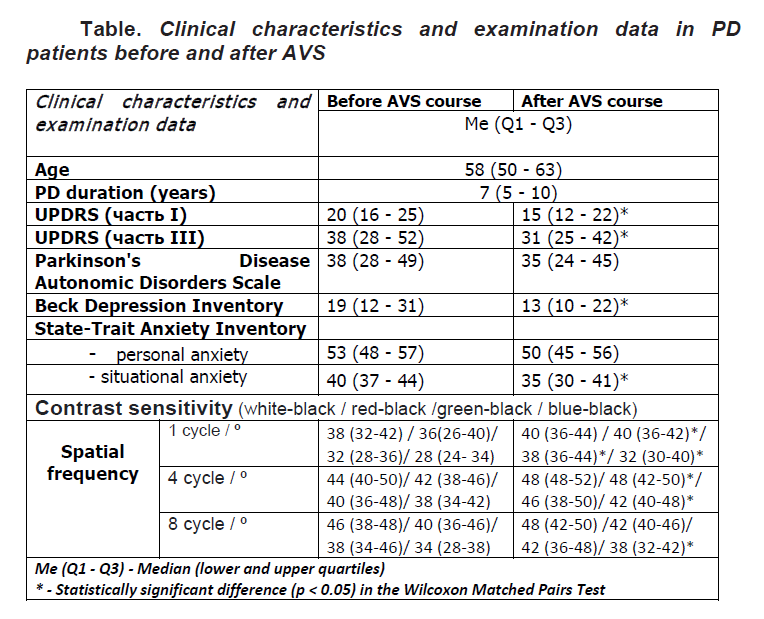Objective: To evaluate the AVS effectiveness in depression, anxiety, autonomic disorders and visual dysfunction in PD patients.
Background: The severity of non-motor dopa-resistant symptoms in PD, such as autonomic dysfunction, emotional and mental disorders, often exhibit diurnal and seasonal variability, suggesting a fundamental role for circadian mechanisms in their development. Light entering the retina not only forms images, but also regulates many physiological and behavioral functions through the retino-hypothalamic pathway (RHP). Targeting the retina and RHP may be considered as a non-pharmacological treatment for some PD symptoms.In addition to light exposure, sound waves in a given rhythm change brain activity and also have a positive effect. In this regard, AVS can be considered as a promising method of neurosensory therapy in PD.
Method: 25 PD patients aged 47 – 65 years were examined before and after the AVS course consisting of 14 sessions.
The following tests were used: UPDRS (part I and III), Parkinson’s Disease Autonomic Disorders Scale (ADS), Beck Depression Inventory and State-Trait Anxiety Inventory. We also examined contrast sensitivity (CS) as one of the most informative methods for assessing visual dysfunction associated with PD.
Results: The ADS revealed that the most frequent and pronounced disorders in PD patients were changes in heart rate variability with a tendency to a fixed pulse, drooling, constipation and nocturia. The depression level was mild or moderate in most cases, and personal anxiety prevailed over situational. A decrease in CS was observed for all color gratings in PD patients.
After AVS course, in addition to the non-motor symptoms improving, PD patients experienced a decrease in the depression severity and situational anxiety. There was no significant improvement in the severity of autonomic disorders in general. However, a number of patients with PD had a decrease in the nocturia manifestations. An improvement in CS, predominantly to blue, was also found (Table).
Conclusion: The positive AVS effect is probably associated with modification of neural pathways to the thalamus where audio and visual information is processed. In addition to stimulating the “direct” visual pathway mediated through the lateral geniculate nucleus, AVS via the RHT, is able to stimulate other brain regions involved in emotion regulation and non-motor manifestations in PD.
Table.
To cite this abstract in AMA style:
O. Alenikova, L. Parkhach, E. Bоsiakova, G. Zobnina. Efficacy of Audiovisual Neuromodulation in the Treatment of Parkinson’s Disease [abstract]. Mov Disord. 2024; 39 (suppl 1). https://www.mdsabstracts.org/abstract/efficacy-of-audiovisual-neuromodulation-in-the-treatment-of-parkinsons-disease/. Accessed March 31, 2025.« Back to 2024 International Congress
MDS Abstracts - https://www.mdsabstracts.org/abstract/efficacy-of-audiovisual-neuromodulation-in-the-treatment-of-parkinsons-disease/

